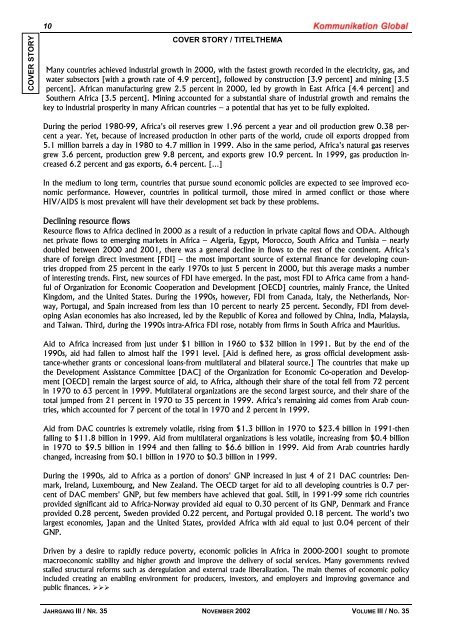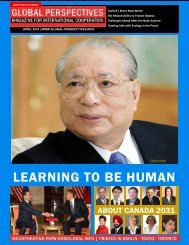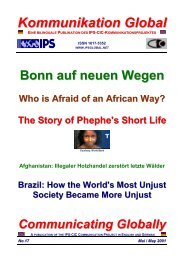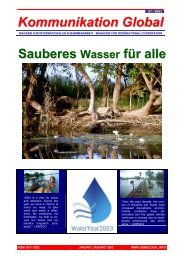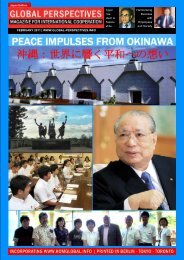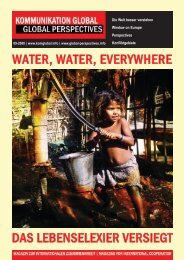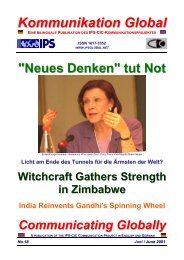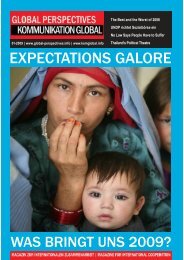Kommunikation Global . Communicating Globally - A Monthly Journal
Kommunikation Global . Communicating Globally - A Monthly Journal
Kommunikation Global . Communicating Globally - A Monthly Journal
Sie wollen auch ein ePaper? Erhöhen Sie die Reichweite Ihrer Titel.
YUMPU macht aus Druck-PDFs automatisch weboptimierte ePaper, die Google liebt.
COVER STORY10COVER STORY / TITELTHEMAMany countries achieved industrial growth in 2000, with the fastest growth recorded in the electricity, gas, andwater subsectors [with a growth rate of 4.9 percent], followed by construction [3.9 percent] and mining [3.5percent]. African manufacturing grew 2.5 percent in 2000, led by growth in East Africa [4.4 percent] andSouthern Africa [3.5 percent]. Mining accounted for a substantial share of industrial growth and remains thekey to industrial prosperity in many African countries – a potential that has yet to be fully exploited.During the period 1980-99, Africa's oil reserves grew 1.96 percent a year and oil production grew 0.38 percenta year. Yet, because of increased production in other parts of the world, crude oil exports dropped from5.1 million barrels a day in 1980 to 4.7 million in 1999. Also in the same period, Africa's natural gas reservesgrew 3.6 percent, production grew 9.8 percent, and exports grew 10.9 percent. In 1999, gas production increased6.2 percent and gas exports, 6.4 percent. […]In the medium to long term, countries that pursue sound economic policies are expected to see improved economicperformance. However, countries in political turmoil, those mired in armed conflict or those whereHIV/AIDS is most prevalent will have their development set back by these problems.Declining resource flowsResource flows to Africa declined in 2000 as a result of a reduction in private capital flows and ODA. Althoughnet private flows to emerging markets in Africa – Algeria, Egypt, Morocco, South Africa and Tunisia – nearlydoubled between 2000 and 2001, there was a general decline in flows to the rest of the continent. Africa'sshare of foreign direct investment [FDI] – the most important source of external finance for developing countriesdropped from 25 percent in the early 1970s to just 5 percent in 2000, but this average masks a numberof interesting trends. First, new sources of FDI have emerged. In the past, most FDI to Africa came from a handfulof Organization for Economic Cooperation and Development [OECD] countries, mainly France, the UnitedKingdom, and the United States. During the 1990s, however, FDI from Canada, Italy, the Netherlands, Norway,Portugal, and Spain increased from less than 10 percent to nearly 25 percent. Secondly, FDI from developingAsian economies has also increased, led by the Republic of Korea and followed by China, India, Malaysia,and Taiwan. Third, during the 1990s intra-Africa FDI rose, notably from firms in South Africa and Mauritius.Aid to Africa increased from just under $1 billion in 1960 to $32 billion in 1991. But by the end of the1990s, aid had fallen to almost half the 1991 level. [Aid is defined here, as gross official development assistance-whethergrants or concessional loans-from multilateral and bilateral source.] The countries that make upthe Development Assistance Committee [DAC] of the Organization for Economic Co-operation and Development[OECD] remain the largest source of aid, to Africa, although their share of the total fell from 72 percentin 1970 to 63 percent in 1999. Multilateral organizations are the second largest source, and their share of thetotal jumped from 21 percent in 1970 to 35 percent in 1999. Africa's remaining aid comes from Arab countries,which accounted for 7 percent of the total in 1970 and 2 percent in 1999.Aid from DAC countries is extremely volatile, rising from $1.3 billion in 1970 to $23.4 billion in 1991-thenfalling to $11.8 billion in 1999. Aid from multilateral organizations is less volatile, increasing from $0.4 billionin 1970 to $9.5 billion in 1994 and then falling to $6.6 billion in 1999. Aid from Arab countries hardlychanged, increasing from $0.1 billion in 1970 to $0.3 billion in 1999.During the 1990s, aid to Africa as a portion of donors' GNP increased in just 4 of 21 DAC countries: Denmark,Ireland, Luxembourg, and New Zealand. The OECD target for aid to all developing countries is 0.7 percentof DAC members' GNP, but few members have achieved that goal. Still, in 1991-99 some rich countriesprovided significant aid to Africa-Norway provided aid equal to 0.30 percent of its GNP, Denmark and Franceprovided 0.28 percent, Sweden provided 0.22 percent, and Portugal provided 0.18 percent. The world's twolargest economies, Japan and the United States, provided Africa with aid equal to just 0.04 percent of theirGNP.Driven by a desire to rapidly reduce poverty, economic policies in Africa in 2000-2001 sought to promotemacroeconomic stability and higher growth and improve the delivery of social services. Many governments revivedstalled structural reforms such as deregulation and external trade liberalization. The main themes of economic policyincluded creating an enabling environment for producers, investors, and employers and improving governance andpublic finances. ‣‣‣JAHRGANG III / NR. 35 NOVEMBER 2002 VOLUME III / NO. 35


